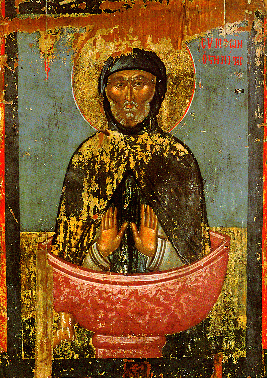St Symeon the
Stylite
 There
have been men who could call forth enthusiasm for Christ
from the pulpit or from monastic cells, but for forty long
years one man did so perched atop a sixty-foot pillar from
which he never descended. He spent a lifetime of extreme
asceticism that spelled out the name of the Saviour
twenty-four hours of every day of that long period. In a
stint of religious fervour that has been imitated many times
since but never duplicated, St. Symeon occupied a confining
space above ground. Like a wingless eagle of the Lord, he
made a spectacular figure against the sky that reminded
everyone below that the only salvation of man could come
through Jesus Christ, In his youth, Symeon was an earthbound
shepherd who had deep Christian roots originating in the
Syrian city of Antioch, the first city to apply the name
"Christian" to the followers of Jesus of Nazareth. Such was
the depth of his faith that it could find expression only
through asceticism. This austerity through monastic life he
was to carry to the extreme not only to completely dedicate
himself to God, but to call to the attention of the world
the need for prayer in Christian worship.
There
have been men who could call forth enthusiasm for Christ
from the pulpit or from monastic cells, but for forty long
years one man did so perched atop a sixty-foot pillar from
which he never descended. He spent a lifetime of extreme
asceticism that spelled out the name of the Saviour
twenty-four hours of every day of that long period. In a
stint of religious fervour that has been imitated many times
since but never duplicated, St. Symeon occupied a confining
space above ground. Like a wingless eagle of the Lord, he
made a spectacular figure against the sky that reminded
everyone below that the only salvation of man could come
through Jesus Christ, In his youth, Symeon was an earthbound
shepherd who had deep Christian roots originating in the
Syrian city of Antioch, the first city to apply the name
"Christian" to the followers of Jesus of Nazareth. Such was
the depth of his faith that it could find expression only
through asceticism. This austerity through monastic life he
was to carry to the extreme not only to completely dedicate
himself to God, but to call to the attention of the world
the need for prayer in Christian worship.
At a time when St. Anthony and St. Savvas were gaining their reputation through monasticism in Egypt, Symeon chose to carry out his ascetic way of life in his native Syria, a land where monastics had been dwarfed by the spiritual giants of other areas. This relative obscurity might have generated his brilliant idea to ascend the pillar, located about sixteen miles from the city of Aleppo on a road leading to Antioch. This was, however, no mere publicity-seeking flagpole stunt. It was a well thought-out plan to present the appealing starkness of a lone figure's vigil for Christ with the bare necessities of life being provided by devoted followers. His self-denial was subordinate to the main purpose of his thought-provoking venture, which was to bring his fellow man an acute awareness of, and a closer proximity to, God. In this he was eminently successful, a price in deprivation he was only too glad to pay.
Symeon's severely restricted abode, in which he could either stand or sit but could not lie down, limited his physical movement, but that seemed only to give him more room for intellectual effort, prayer, and meditation. Known as a stylite, or one who lives on a pillar, he virtually impaled himself physically for a lifetime but thereby gained spiritual eternity. Inured to the hardships of this inhuman existence, he was able to withstand rigours which by any standard would be unbearable, and it is not hard to believe that in one Lenten season he stood erect for twenty days, then sat in meditation for another twenty days, during which time his only sustenance was water.
Considered to be by far the greatest ascetic in all Christendom, Symeon sat or stood stoically atop his pillar, which over the years beckoned thousands of Christian pilgrims who came to view this amazing spectacle and to hear the wisdom of the solitary anchorite, whose weather-beaten visage inspired countless numbers to reaffirm their faith in God and his only begotten Son. Added to the wonder of his durability under the most demanding circumstances was his power of miraculous healing through the power of the Lord, as a result of which he came to be venerated as a saint while still alive. Symeon had spent a number of years in his cramped quarters when he was besieged by his followers to descend back into the society of man, assuring him that his purpose had been more than fulfilled and that he was entitled to the comforts of hearth and home, even perhaps the high post in the hierarchy. Symeon refused to come down, saying only that he had made a solemn vow that his only descent would come after his death.
The ruins of St. Symeon's pillar are still evident in Syria and are considered a shrine to the greatest ascetic of them all who died in A.D. 459 after establishing a precedent which many followed later but none were able to equal.
from Orthodox Saints, v. 3
Holy Cross Orthodox Press